
The Mazda 787 and its derivative 787B are Group C sports prototype racing cars that were developed by Japanese automobile manufacturer Mazda for use in the World Sportscar Championship, All Japan Sports Prototype Championship, and the 24 Hours of Le Mans from 1990 to 1991. Designed to combine a mixture of the Fédération Internationale du Sport Automobile (FISA) Group C regulations with the International Motor Sports Association (IMSA) GTP regulations, the 787s were the last Wankel rotary-powered racing cars to compete in the World and Japanese championships, using Mazda's R26B engine.

The Jaguar XJ220 is a two-seat sports car produced by British luxury car manufacturer Jaguar from 1992 until 1994, in collaboration with the specialist automotive and race engineering company Tom Walkinshaw Racing. The XJ220 recorded a top speed of 212.3 mph (341.7 km/h) during testing by Jaguar at the Nardo test track in Italy. This made it the fastest production car from 1992 to 1993. According to Jaguar, an XJ220 prototype managed a Nürburgring lap time of 7:46.36 in 1991 which was faster than any production car lap time before it.

The Jaguar Sport XJR-15 is a two-seater sports car produced by JaguarSport, a subsidiary of Jaguar and Tom Walkinshaw Racing between 1990 and 1992. Only 50 were planned, each selling for £500,000.

Road Atlanta is a 2.540 mi (4.088 km) road course located just north of Braselton, Georgia, United States. The facility is utilized for a wide variety of events, including professional and amateur sports car and motorcycle races, racing and driving schools, corporate programs and testing for motorsports teams. The track has 12 turns, including the famous "esses" between turns three and five; and Turn 12, a downhill, diving turn. The track is owned by IMSA Holdings, LLC through its subsidiary Road Atlanta, LLC, and is the home to the Petit Le Mans, as well as AMA motorcycle racing, and smaller events throughout the year. Michelin acquired naming rights to the facility in 2018.
Tom Walkinshaw Racing (TWR) was a motor racing team and engineering firm founded in 1976, in Kidlington, near Oxford, England, by touring car racer Tom Walkinshaw.

The Jaguar XJR-9 is a sports-prototype race car built by Jaguar for both FIA Group C and IMSA Camel GTP racing, debuting at the 1988 24 Hours of Daytona.

The 1989 24 Hours of Le Mans was the 57th Grand Prix of Endurance, taking place at the Circuit de la Sarthe, France, on the 10 and 11 June 1989. This year it was not included as a round of the 1989 World Sports-Prototype Championship. The entry list promised a strong contest between five manufacturers. Jaguar had won in 1988 and went on to win the championship; while Sauber had finished second and was now matching Jaguar on the track. New regulations were coming in 1991, and the first examples of the 3.5-litre normally-aspirated formula were entered by Spice Engineering.

The Jaguar XJR-14 is a sports-prototype racing car introduced for the 1991 World Sportscar Championship season. It was designed by Ross Brawn and John Piper, and was built and run by Tom Walkinshaw Racing (TWR), on behalf of Jaguar Cars.

The 1992 Sportscar World Championship season was the 40th and final season of FIA World Sportscar Championship motor racing. It featured the 1992 FIA Sportscar World Championship, which was contested over a six race series which ran from 26 April to 18 October 1992. The championship was open to Group C Sportscars.

The Jaguar XJR sportscars were a series of race cars used by Jaguar-backed teams in both the World Sportscar Championship (WSC) Group C and the IMSA Camel GTP series between 1984 and 1993.
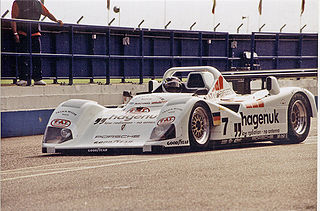
The Porsche WSC-95 was a Le Mans Prototype originally built by Tom Walkinshaw Racing. It was modified by Porsche from the original Group C Jaguar XJR-14 from which it derived, and run by Joest Racing. Originally intended to race in the IMSA World Sportscar Championship, the WSC-95 saw very little race action even though it won the 24 Hours of Le Mans in both 1996 and 1997 without being acknowledged as a factory supported project. It was later upgraded to the Porsche LMP1-98 before being retired. Only two cars were ever built.
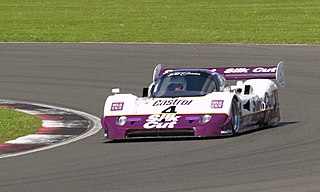
The Jaguar XJR-11 was a sports-prototype racing car introduced for the 1989 World Sports Prototype Championship, while its sister car the XJR-10 was introduced to compete in IMSA series races.
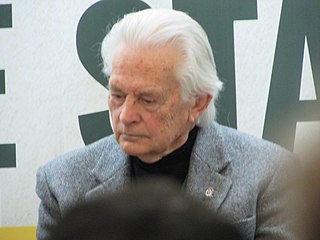
Tony Southgate is an English engineer and former racing car designer. He designed many successful cars, including Jaguar's Le Mans-winning XJR-9, and cars for almost every type of circuit racing. He was responsible for the chassis design of Ford's RS200 Group B rally car. Southgate was employed as chief designer or technical director for many Formula One teams for over twenty years. These teams included BRM, Shadow and Arrows. Southgate retired after producing the Audi R8C, which was a major influence in the Bentley Speed 8, which won Le Mans in 2003. He continues to be a regular visitor to current and historic race meetings.
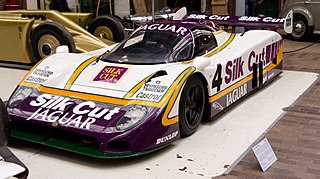
The XJR-8 was a race car built by Jaguar for campaigning in the World Sportscar Championship and the 24 Hours of Le Mans as part of Group C. It was used during the 1987 season.

The Eagle MkIII is a sports prototype racing car built by All American Racers in 1991 to IMSA GTP specifications. Powered by a turbocharged Toyota inline-4 engine, the car was campaigned in the IMSA Camel GT series by Dan Gurney's Toyota-sponsored AAR team from 1991 through to the end of 1993. The Eagle MkIII won 21 out of the 27 races in which it was entered and is considered one of the most successful and technologically advanced designs of the IMSA GTP era — "a car that proved so overwhelmingly dominant that the class for which it was created has now been assigned to history", according to Racer magazine.

The Jaguar XJR-10 is an IMSA GTP sports prototype race car, designed, developed, and built by TWR for Jaguar, with the aim of competing, from 1989, in the IMSA GT Championship. Jaguar XJR-10s competed until 1991, before Jaguar replaced it with the Jaguar XJR-16. The car debuted a new 3.0-liter twin-turbo V6 engine, which replaced the previous V12, and was later fitted to the Jaguar XJ220 as well.
The Jaguar XJR-17 was an IMSA Lights racing car, built by Tom Walkinshaw Racing. Rebuilt from a Jaguar XJR-16 for the IMSA Camel Lights, the XJR-17 never competed in the event due to funding issues and has since only been used in a few minor British events and historic races. It used a modified version of the XJR-16's 3.5-litre V6 engine, stripped of the twin-turbochargers and producing a claimed output of 450 hp, whilst its bodywork was cobbled together using various parts from older Jaguar XJR Sportscars.

The Jaguar XJR-7 is a IMSA GTP sports prototype race car, designed, developed, and built by Group 44, for Jaguar with the aim of competing, from 1985, in the IMSA GT Championship. Jaguar XJR-7s contested until 1988, before Jaguar replaced it with the Jaguar XJR-9.
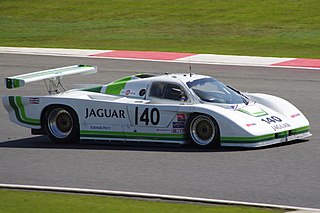
The Jaguar XJR-5 is a IMSA GTP sports prototype race car, designed, developed and built by Group 44 racing for Jaguar with the aim of competing, from 1982, in the IMSA GT Championship. Jaguar XJR-5s contested until 1985, before Jaguar replaced it with the Jaguar XJR-7.

The March 86G was a Group C and IMSA GTP sports racing car built by March Engineering. Built as simply a chassis with no engine, it was branded as one of three cars, the BMW GTP, the Buick Hawk or the Nissan R86V depending on which engine was placed in the chassis and which team was running it. There were a number of subtle bodywork changes to reflect the manufacturer which ran the car.


















